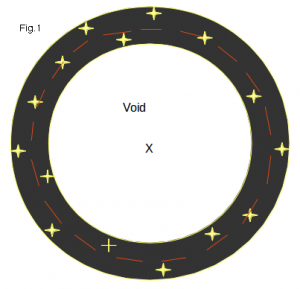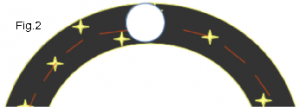Collapsing Universe Theory
A mechanism for the expansion of the universe,
giving insight into the shape and size of the universe,
explaining the accelerated expansion rate of the universe,
and solving the dark matter problem
Paul Brooks
2nd December 2017
Updated July 2025
Expansion of the universe.
Let us start at the beginning with the Big Bang and the way it expands to form the shape of the universe that I envisage (Fig.1 showing a cross section of the spherical universe).
See details of this animation at the bottom

An analogy for the Big Bang would be like having a high pressure water hose with no gravity or matter around. Pull the trigger and you get a high speed jet of water shooting out in a straight line from the nozzle. A short while later release the trigger and the water stops coming out of the nozzle. The expelled water continues its speed and trajectory leaving an increasing gap between the last drop of water to exit the nozzle and the end of the nozzle itself. Now equate the nozzle to the point of the Big Bang and have the jet coming out in all directions. But not a jet of water but of extremely hot energy. This creates an expanding thin shell-like structure around the origin of the Big Bang.

As this energy moves rapidly away from the Big Bang (point X in Fig.1) it will leave a growing void inside the shell of energy. This energy / plasma starts cooling and changing to gas, creating gravity and gas pressure. The void has zero pressure as does the space outside of the shell so doesn’t hinder the first expansion. The newly created gas and the associated gas pressure starts the second expansion. This second expansion forces gas from this what I will call the mid point or origin of the second expansion both inwards and outwards. It creates a thickening shell while the shell itself continues to expand from the Big Bang.
The first stars form from this newly created gas. When the explosions of these first stars occur they break up the gas cloud starting the formation of the galaxies. The debris from the explosion moves rapidly in all directions so when it collects together forming these galaxies then the galaxies attain their speed and direction.
So there are two different expansions happening at the same time. The expansion of gas and the explosions of the stars are the second expansion acting on top of the much faster to begin with, first expansion, produced by the Big Bang.
Accelerated expansion rate.
There are two options:-
i) there is too little mass and the universe expands forever or
ii) there is enough mass to cause the universe to collapse.
I will assume option ii and see where it takes us.
I will also assume (for ease of description) our galaxy is at the mid point between the inner and outer perimeters of the global universe.
Expansion a) The outer perimeter of the global universe with reference to X.
Expansion b) The diameter of the visible universe which continues to expand to this day.
The speed of the expanding universe gradually slows because of gravity until it stops expanding (expansion a), remembering that the global universe is still expanding (expansion b). Referring back to Fig.1 the speed of expansion from X will differ at the inner, mid and outer points of the ring. The inner edge of the global universe will stop expanding first and start to accelerate back towards X while accelerating away from us at the mid point. In turn our expansion at the mid point will slow to a stop and then start accelerating away from the outer perimeter and back towards X. And finally the outer perimeter will stop expanding and start accelerating back towards X.
This acceleration was thought to have started around 6 billion years ago, so going by the evidence the universe is now collapsing at an accelerating rate.
Dark energy and dark matter solution.
The void from X to the inner perimeter of the visible universe is so large that the radius around our visible section of the universe is only part of the distance around the circumference of the global universe. So we have to multiply this area until it covers the whole sphere of the universe. This shows that there is enough matter in the universe for it to collapse.
Dark energy and/or dark matter are not required in order to explain the expansion and collapse of the universe. The visible part of the universe is only a small part of the actual global universe.
The white circle in Fig.2 is a representation of the visible universe in relation to the global universe. The distance from the inner edge to outer edge would have to be at least the size of the visible universe and most probably a lot bigger or that would put us at the mid point which is highly unlikely.

Blue Shift, Red Shift.
Evidence of the collapsing universe should be visible in the stars.
To make the explanation easier I will presume that all galaxies move in a straight line directly towards or away from the Big Bang (point X) though in reality most galaxies will have additional sideways motion of varying degrees.
1. Take two galaxies, the same distance from us and on either side of us, and all three in line with the Big Bang. The galaxy furthest from the Big Bang will have a certain red shift looking from our perspective. The Galaxy nearer to the Big Bang will have a larger red shift because it started accelerating towards the Big Bang sooner.
2. As the universe at our distance from X starts collapsing there will be a thin disc of blue shifted galaxies formed, centred on us, perpendicular to the centre line going from point X through us and beyond. The radius of this blue shifted disc of galaxies will today be about the distance from us to the distance light has travelled since the global universe started to collapse about 6 billion years ago. As this disc of galaxies moves towards X, the galaxies, being on the same radius as us, will be moving slightly towards each other and therefore be blue shifted because the distance between any two galaxies on the same radius will be decreasing as they approach X. In addition, the further away a blue shifted galaxy is from us that is on the same radius as us with respect to X, the more of an additional velocity it will have towards us, making the galaxy more blue shifted.
For inner galaxies, the galaxies slightly nearer to X than ourselves will be slightly red shifted and be more red shifted the nearer they are to X.
For outer galaxies, the galaxies slightly further away from X than ourselves will be slightly red shifted and be more red shifted the further away from us they are.
For galaxies slightly further away from us than the 6 billion light years there should be some sort of boundary where we haven’t yet seen the change of direction and/or acceleration.
Galaxies further away than about 6 billion years will be seen as moving away from us at the expansion rate of the universe before the acceleration started for us.
The radius of the disc will give us a small arc around X, which if we extend around in a full circle will give us the size of the global universe.
But what we see will be distorted due to the time lag of the light reaching us from the galaxies on this arc. The disc’s shape (flatness) will depend on the radius of the global universe at our distance from X and the speed of the acceleration of the galaxies towards X. This is something like what I expect to see but with the many variables and without doing any simulations its hard to say exactly what will be seen.

This animation shows a red dot for each of the identical galaxies moving as described above. Some random galaxies are highlighted with white dots to make it easier to see their movements through the life cycle of the universe. This is not intended to represent a gravitational simulation simply a 2D representation in space. Space and/or space/time does not stretch and is not stretched anywhere. There are only about 5,000 galaxies in the animation. The ratios of the diameter of the universe and the thickness of the second expansion are just one possible scenario of many.
All figures and animations are simple, diagrammatic representations and not to scale.
